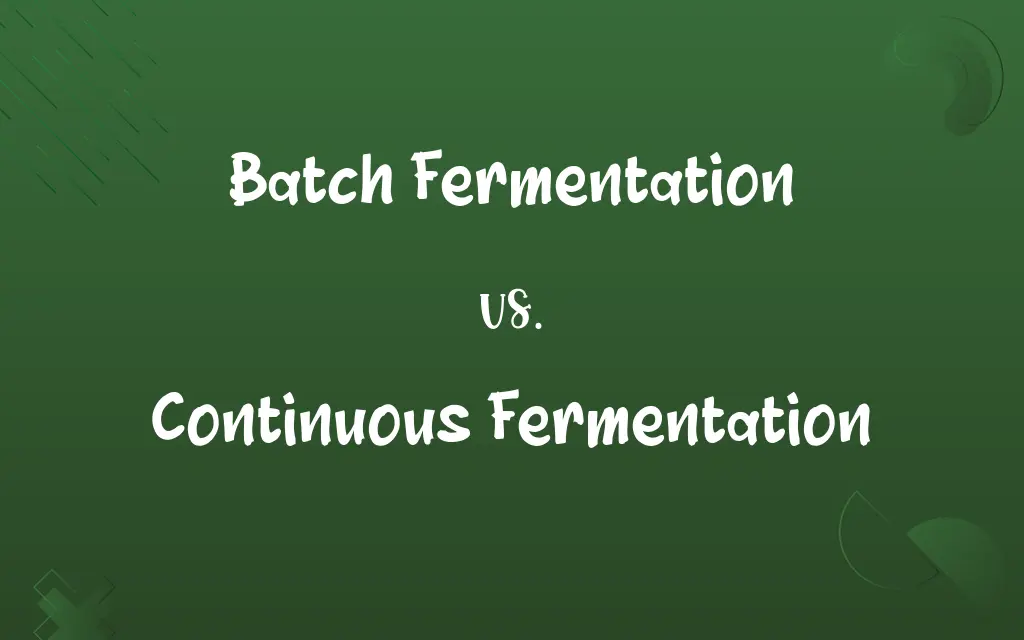Batch Fermentation vs. Continuous Fermentation: Know the Difference

By Shumaila Saeed || Published on February 10, 2024
Batch Fermentation is a finite process where nutrients are added at the start and products are harvested at the end, whereas Continuous Fermentation involves a steady input of nutrients and continuous product harvest.

Key Differences
Batch Fermentation is a closed-system fermentation process where all ingredients are added at the beginning, and the product is harvested upon completion. In Continuous Fermentation, the process is open, with continuous addition of substrates and simultaneous removal of end products, allowing for an ongoing fermentation cycle.
Shumaila Saeed
Feb 10, 2024
In Batch Fermentation, the environment changes over time as substrates are depleted and products accumulate, which can affect the rate and efficiency of fermentation. Continuous Fermentation, however, maintains a more stable environment as fresh medium is constantly supplied, and products are continuously removed, leading to a more consistent fermentation process.
Shumaila Saeed
Feb 10, 2024
Batch Fermentation typically experiences a lag phase, a log phase, a stationary phase, and a death phase, reflecting the changing conditions in the fermenter. Continuous Fermentation avoids these distinct phases by constantly renewing the medium, which can sustain the microorganisms in an optimal growth phase for longer periods.
Shumaila Saeed
Feb 10, 2024
The scale of production in Batch Fermentation is limited by the size of the fermenter and the duration of the fermentation process. Continuous Fermentation, on the other hand, can potentially produce larger quantities over a prolonged period as it is not limited by batch size, making it more suitable for large-scale production.
Shumaila Saeed
Feb 10, 2024
Batch Fermentation is often simpler to set up and more adaptable to different products but requires cleaning and setup between batches. Continuous Fermentation is more complex to manage due to the need for constant monitoring and control but can be more efficient for products requiring consistent quality and large-scale production.
Shumaila Saeed
Feb 10, 2024
ADVERTISEMENT
Comparison Chart
Scale of Production
Limited by batch size
Suitable for large-scale, prolonged production
Shumaila Saeed
Feb 10, 2024
ADVERTISEMENT
Phase Transition
Distinct phases (lag, log, stationary, death)
Sustains optimal growth phase
Shumaila Saeed
Feb 10, 2024
Suitability
Versatile for various products
Ideal for consistent, large-scale production
Shumaila Saeed
Feb 10, 2024
Operational Complexity
Simpler setup, requires cleaning between batches
Complex, requires constant monitoring and control
Shumaila Saeed
Feb 10, 2024
Batch Fermentation and Continuous Fermentation Definitions
Batch Fermentation
It involves adding all ingredients at the start and harvesting at the end.
Batch Fermentation was perfect for producing the seasonal wine.
Shumaila Saeed
Jan 11, 2024
Continuous Fermentation
It maintains a constant fermentation environment by adding fresh substrates.
Continuous Fermentation ensured a steady supply of enzymes for industrial use.
Shumaila Saeed
Jan 11, 2024
ADVERTISEMENT
Batch Fermentation
Batch Fermentation requires downtime for cleaning between batches.
After each Batch Fermentation, the equipment was thoroughly cleaned.
Shumaila Saeed
Jan 11, 2024
Continuous Fermentation
It requires sophisticated control and monitoring systems.
The biotech facility invested in advanced systems for their Continuous Fermentation process.
Shumaila Saeed
Jan 11, 2024
Batch Fermentation
Batch Fermentation undergoes distinct microbial growth phases.
The cheese was developed using Batch Fermentation, ensuring distinct flavor development.
Shumaila Saeed
Jan 11, 2024
Continuous Fermentation
Continuous Fermentation involves a steady process with ongoing input and output.
The biofuel plant utilized Continuous Fermentation for consistent production.
Shumaila Saeed
Jan 11, 2024
Batch Fermentation
Batch Fermentation is a finite fermentation process in a closed system.
The brewery used Batch Fermentation for their limited-edition beer.
Shumaila Saeed
Jan 11, 2024
Continuous Fermentation
Continuous Fermentation is ideal for large-scale, consistent product output.
The pharmaceutical company employed Continuous Fermentation for mass production of vaccines.
Shumaila Saeed
Jan 11, 2024
Batch Fermentation
This method is suitable for small to medium-scale production.
Batch Fermentation was chosen for the experimental batch of antibiotics.
Shumaila Saeed
Jan 11, 2024
Continuous Fermentation
This method avoids the distinct phases of microbial growth.
Continuous Fermentation was used to maintain yeast cells in their most productive phase.
Shumaila Saeed
Jan 11, 2024
Repeatedly Asked Queries
What is Batch Fermentation?
Batch Fermentation is a finite fermentation process where all substrates are added at the start, and products are harvested after the process completes.
Shumaila Saeed
Feb 10, 2024
What type of fermentation is better for experimental or unique products?
Batch Fermentation is often better for experimental or unique products due to its flexibility and adaptability.
Shumaila Saeed
Feb 10, 2024
What industries commonly use Batch Fermentation?
Batch Fermentation is common in industries like brewing, winemaking, and pharmaceuticals where batch-specific quality is crucial.
Shumaila Saeed
Feb 10, 2024
Is Continuous Fermentation more energy-efficient than Batch Fermentation?
Continuous Fermentation can be more energy-efficient in long-term, large-scale production scenarios.
Shumaila Saeed
Feb 10, 2024
What is Continuous Fermentation?
Continuous Fermentation is an ongoing fermentation process with continuous addition of substrates and removal of products.
Shumaila Saeed
Feb 10, 2024
How does Batch Fermentation differ from Continuous Fermentation in terms of scale?
Batch Fermentation is typically used for smaller scale production, while Continuous Fermentation is more suited for large-scale, consistent production.
Shumaila Saeed
Feb 10, 2024
What are the benefits of Continuous Fermentation in industrial production?
Continuous Fermentation offers benefits like consistent product quality, efficiency in large-scale production, and reduced labor costs.
Shumaila Saeed
Feb 10, 2024
What are the main challenges of Batch Fermentation?
The main challenges include the need for downtime between batches and the variability in product quality between batches.
Shumaila Saeed
Feb 10, 2024
How do the fermentation phases differ in Batch vs. Continuous Fermentation?
Batch Fermentation experiences distinct phases (lag, log, stationary, death), while Continuous Fermentation maintains microorganisms in a constant growth phase.
Shumaila Saeed
Feb 10, 2024
What makes Continuous Fermentation suitable for standard products?
Its ability to provide a consistent and steady production environment makes it suitable for standard, high-demand products.
Shumaila Saeed
Feb 10, 2024
Is Continuous Fermentation more complex than Batch Fermentation?
Yes, Continuous Fermentation is generally more complex due to the need for constant monitoring and control of the fermentation environment.
Shumaila Saeed
Feb 10, 2024
Can Batch Fermentation be used for continuous production?
No, Batch Fermentation is not designed for continuous production; it requires downtime between batches for cleaning and setup.
Shumaila Saeed
Feb 10, 2024
Which fermentation method is better for producing beer?
Most beers are produced using Batch Fermentation, which allows for specific control over each batch's flavor profile.
Shumaila Saeed
Feb 10, 2024
Can Continuous Fermentation handle different types of substrates?
Continuous Fermentation can handle different substrates, but it often requires a stable and consistent substrate for optimal operation.
Shumaila Saeed
Feb 10, 2024
How does product quality compare in Batch and Continuous Fermentation?
Batch Fermentation allows for batch-specific quality control, while Continuous Fermentation ensures consistent quality over time.
Shumaila Saeed
Feb 10, 2024
What are the main challenges of Continuous Fermentation?
The main challenges include the complexity of setup and the need for sophisticated monitoring and control systems.
Shumaila Saeed
Feb 10, 2024
What is a key advantage of Batch Fermentation?
A key advantage of Batch Fermentation is the ability to produce a variety of products with different fermentation profiles.
Shumaila Saeed
Feb 10, 2024
Can Batch Fermentation be automated?
Yes, Batch Fermentation can be automated, though it still requires manual intervention for setup and cleaning.
Shumaila Saeed
Feb 10, 2024
Is Continuous Fermentation used in wastewater treatment?
Yes, Continuous Fermentation is used in some wastewater treatment processes due to its efficiency in continuous biodegradation.
Shumaila Saeed
Feb 10, 2024
Is Batch Fermentation more labor-intensive than Continuous Fermentation?
Yes, Batch Fermentation can be more labor-intensive due to the need for manual setup, monitoring, and cleaning between batches.
Shumaila Saeed
Feb 10, 2024
Share this page
Link for your blog / website
HTML
Link to share via messenger
About Author
Written by
Shumaila SaeedShumaila Saeed, an expert content creator with 6 years of experience, specializes in distilling complex topics into easily digestible comparisons, shining a light on the nuances that both inform and educate readers with clarity and accuracy.








































































